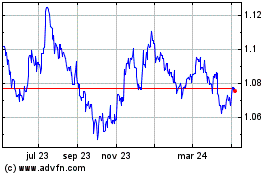U.S. Consumer Price Growth Slows Less Than Expected In April
11 Mayo 2022 - 4:31AM
RTTF2
A highly anticipated report released by the Labor Department on
Wednesday showed the annual rate of U.S. consumer price growth
slowed by less than expected in the month of April.
The Labor Department said consumer prices in April were up by
8.3 percent compared to the same month a year ago.
While the annual rate of growth slowed from a 40-year high of
8.5 percent in March, economists had expected the pace of growth to
slow to 8.1 percent.
Energy prices skyrocketed by 30.3 percent year-over-year, while
food prices spiked by 9.4 percent, reflecting the largest yearly
increase since the period ending April 1981.
The annual rate of growth in core consumer prices, which exclude
food and energy prices, also slowed to 6.2 percent in April from
6.5 percent in March, although the rate was expected to decelerate
to 6.0 percent.
Prices for shelter and medical care jumped 5.1 percent and 3.2
percent, respectively, while prices for used cars and trucks and
new vehicles also showed notable yearly increases.
The report showed prices for airline fares also soared 33.3
percent over the last year, reflecting the largest 12-month
increase since the period ending December 1980.
On a monthly basis, the Labor Department said its consumer price
index rose by 0.3 percent in April after surging by 1.2 percent in
March. Economists had expected prices to edge up by 0.2
percent.
The relatively modest monthly price growth came as energy prices
tumbled by 2.7 percent in April after spiking by 11.0 percent in
the previous month.
The Labor Department said prices for gasoline plunged by 6.1
percent over the month, offsetting increases in prices for natural
gas and electricity.
Meanwhile, the report showed prices for food advanced by 0.9
percent in April after jumping by 1.0 percent in March.
Excluding food and energy prices, core consumer prices climbed
0.6 percent in April after rising by 0.3 percent in March. Core
prices were expected to increase by 0.4 percent.
The bigger than expected increase in core prices was partly due
to an 18.6 percent surge in prices for airline fares, which
reflected the biggest one-month spike since the inception of the
series in 1963.
Notable increases in prices for shelter and new vehicles also
contributed to the core consumer price growth along with higher
prices for medical care, recreation, and household furnishings and
operations
On the other hand, the Labor Department said prices for apparel,
communication, and used cars and trucks all declined over the
month.
"Overall, the April data will probably strengthen the Fed's
resolve to continue hiking rates by 50bp at the next couple of
meetings - and could lead to renewed speculation about a 75bp hike
or an inter-meeting move," Andrew Hunter, Senior U.S. Economist at
Capital Economics.
He added, "But with goods shortages tentatively easing and signs
that wage growth is set to cool, we still think a more pronounced
drop back in inflation will allow officials to slow the pace of
tightening in the second half of the year."
On Thursday, the Labor Department is scheduled to release a
separate report on producer price inflation in the month of
April.
Economists currently expect producer prices to rise by 0.5
percent in April after jumping by 1.4 percent in March, while the
annual rate of growth is expected to slow to 10.7 percent from 11.2
percent.
Euro vs US Dollar (FX:EURUSD)
Gráfica de Divisa
De Mar 2024 a Abr 2024

Euro vs US Dollar (FX:EURUSD)
Gráfica de Divisa
De Abr 2023 a Abr 2024
